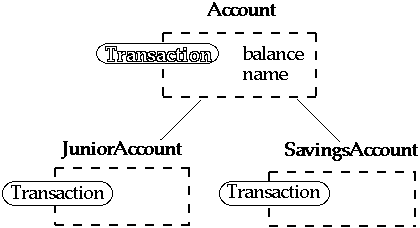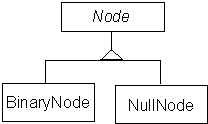
Spring Semester, 2005
Template Method & Null Object
© 2005, All Rights Reserved, SDSU & Roger Whitney
San Diego State University -- This page last updated 03-Feb-05

|
Advanced Object-Oriented Design & Programming
Spring Semester, 2005 Template Method & Null Object |
|
|---|---|---|
|
© 2005, All Rights Reserved, SDSU & Roger Whitney San Diego State University -- This page last updated 03-Feb-05 |
Implementing a Template Method
Copyright ©, All rights reserved. 2005 SDSU & Roger Whitney, 5500 Campanile Drive, San Diego, CA 92182-7700 USA. OpenContent ( http://www.opencontent.org/opl.shtml) license defines the copyright on this document.
| CS 635 Spring 05 | Doc 4, Template Method & Null Object Slide # 2 |
http://c2.com/cgi/wiki?TemplateMethodPattern WikiWiki comments on the Template Method
http://wiki.cs.uiuc.edu/PatternStories/TemplateMethodPattern Stories about the Template Method
Design Patterns: Elements of Resuable Object-Oriented Software, Gamma, Helm, Johnson, Vlissides, Addison Wesley, 1995, pp. 325-330
The Design Patterns Smalltalk Companion, Alpert, Brown, Woolf, Addision-Wesley, 1998,pp. 355-370
Refactoring: Improving the Design of Existing Code, Fowler, 1999, pp. 260-266
“Null Object”, Woolf, in Pattern Languages of Program Design 3, Edited by Martin, Riehle, Buschmmann, Addison-Wesley, 1998, pp. 5-18
Design Patterns: Elements of Resuable Object-Oriented Software, Gamma, Helm, Johnson, Vlissides, Addison Wesley, 1995, pp. 325-330
The Design Patterns Smalltalk Companion, Alpert, Brown, Woolf, Addision-Wesley, 1998,pp. 355-370
| CS 635 Spring 05 | Doc 4, Template Method & Null Object Slide # 3 |
class Account {
public:
void virtual Transaction(float amount)
{ balance += amount;}
Account(char* customerName, float InitialDeposit = 0);
protected:
char* name;
float balance;
}
class JuniorAccount : public Account {
public: void Transaction(float amount) {// put code here}
}
class SavingsAccount : public Account {
public: void Transaction(float amount) {// put code here}
}
Account* createNewAccount()
{
// code to query customer and determine what type of
// account to create
};
main() {
Account* customer;
customer = createNewAccount();
customer->Transaction(amount);
}
| CS 635 Spring 05 | Doc 4, Template Method & Null Object Slide # 4 |

class Account {
public:
void virtual Transaction() = 0;
}
class JuniorAccount : public Account {
public
void Transaction() { put code here}
}
| CS 635 Spring 05 | Doc 4, Template Method & Null Object Slide # 5 |

class Account {
public:
void Transaction(float amount);
void virtual TransactionSubpartA();
void virtual TransactionSubpartB();
void virtual TransactionSubpartC();
}
void Account::Transaction(float amount) {
TransactionSubpartA(); TransactionSubpartB();
TransactionSubpartC(); // EvenMoreCode;
}
class JuniorAccount : public Account {
public: void virtual TransactionSubpartA(); }
class SavingsAccount : public Account {
public: void virtual TransactionSubpartC(); }
Account* customer;
customer = createNewAccount();
customer->Transaction(amount);
| CS 635 Spring 05 | Doc 4, Template Method & Null Object Slide # 6 |
Define the skeleton of an algorithm in an operation, deferring some steps to subclasses
Template Method lets subclasses redefine certain steps of an algorithm without changing the algorithm’s structure
An application framework with Application and Document classes
Abstract Application class defines the algorithm for opening and reading a document
void Application::OpenDocument (const char* name ) {
if (!CanNotOpenDocument (name)) {
return;
}
Document* doc = DoCreateDocument();
if (doc) {
_docs->AddDocument( doc);
AboutToOpenDocument( doc);
Doc->Open();
Doc->DoRead();
}
}
| CS 635 Spring 05 | Doc 4, Template Method & Null Object Slide # 7 |
Object>>printString
| aStream |
aStream := WriteStream on: (String new: 16).
self printOn: aStream.
^aStream contents
Object>>printOn: aStream
| title |
title := self class printString.
aStream nextPutAll:
((title at: 1) isVowel ifTrue: ['an '] ifFalse: ['a ']).
aStream nextPutAll: title
Object provides a default implementation of printOn:
Subclasses just override printOn:
| CS 635 Spring 05 | Doc 4, Template Method & Null Object Slide # 8 |
Standard collection iterators
collect:, detect:, do:, inject:into:, reject:, select:
Collection>>collect: aBlock | newCollection | newCollection := self species new. self do: [:each | newCollection add: (aBlock value: each)]. ^newCollection Collection>>do: aBlock self subclassResponsibility Collection>>inject: thisValue into: binaryBlock | nextValue | nextValue := thisValue. self do: [:each | nextValue := binaryBlock value: nextValue value: each]. ^nextValue Collection>>reject: aBlock ^self select: [:element | (aBlock value: element) == false] Collection>>select: aBlock | newCollection | newCollection := self species new. self do: [:each | (aBlock value: each) ifTrue: [newCollection add: each]]. ^newCollection
Subclasses only have to implement:
| CS 635 Spring 05 | Doc 4, Template Method & Null Object Slide # 9 |
Template Method pattern should be used:
Subclasses implement behavior that can vary
To control subclass extensions
Template method defines hook operations Subclasses can only extend these hook operations
| CS 635 Spring 05 | Doc 4, Template Method & Null Object Slide # 10 |

Defines abstract primitive operations that concrete subclasses define to implement steps of an algorithm Implements a template method defining the skeleton of an algorithm
Implements the primitive operations Different subclasses can implement algorithm details differently
| CS 635 Spring 05 | Doc 4, Template Method & Null Object Slide # 11 |
This is the most commonly used of the 23 GoF patterns
Important in class libraries
Inverted control structure
Parent class calls subclass methods Java's paint method is a primitive operation called by a parent method Beginning Java programs don't understand how the following works:
import java.awt.*;
class HelloApplication extends Frame
{
public void paint( Graphics display )
{
int startX = 30;
int startY = 40;
display.drawString( "Hello World", startX, startY );
}
}
| CS 635 Spring 05 | Doc 4, Template Method & Null Object Slide # 12 |
Template methods tend to call:
Methods called in Template method and have default implementation in AbstractClass Provide default behavior that subclasses can extend Smalltalk's printOn: aStream is a hook operation
It is important to denote which methods
| CS 635 Spring 05 | Doc 4, Template Method & Null Object Slide # 13 |
Using C++ access control
Minimize primitive operations
Naming conventions
| CS 635 Spring 05 | Doc 4, Template Method & Null Object Slide # 14 |
Implement all of the code in one method The large method you get will become the template method
Use comments to break the method into logical steps One comment per step
Implement separate method for each of the steps
Rewrite the template method to call the step methods
Repeat the above steps on each of the step methods Continue until:
All steps in each method are at the same level of generality All constants are factored into their own methods
| CS 635 Spring 05 | Doc 4, Template Method & Null Object Slide # 15 |
Template method is common in lazy initialization [2]
public class Foo {
Bar field;
public Bar getField() {
if (field == null)
field = new Bar( 10);
return field;
}
}
What happens when subclass needs to change the default field value?
public Bar getField() {
if (field == null)
field = defaultField();
return field;
}
protected Bar defaultField() {
return new Bar( 10);
}
Now a subclass can just override defaultField()
| CS 635 Spring 05 | Doc 4, Template Method & Null Object Slide # 16 |
The same idea works in constructors
public Foo() {
field := defaultField();
}
Now a subclass can change the default value of a field by overriding the default value method for that field
| CS 635 Spring 05 | Doc 4, Template Method & Null Object Slide # 17 |

NullObject implements all the operations of the real object,
These operations do nothing or the correct thing for nothing
| CS 635 Spring 05 | Doc 4, Template Method & Null Object Slide # 18 |
public class BinaryNode {
Node left = new NullNode();
Node right = new NullNode();
int key;
public boolean includes( int value ) {
if (key == value)
return true;
else if ((value < key) & left == null) )
return false;
else if (value < key)
return left.includes( value );
else if (right == null)
return false;
else
return right.includes(value);
}
etc.
}
| CS 635 Spring 05 | Doc 4, Template Method & Null Object Slide # 19 |


| CS 635 Spring 05 | Doc 4, Template Method & Null Object Slide # 20 |
public class BinaryNode extends Node {
Node left = new NullNode();
Node right = new NullNode();
int key;
public boolean includes( int value ) {
if (key == value)
return true;
else if (value < key )
return left.includes( value );
else
return right.includes(value);
}
etc.
}
public class NullNode extends Node {
public boolean includes( int value ) {
return false;
}
etc.
}
| CS 635 Spring 05 | Doc 4, Template Method & Null Object Slide # 21 |
No need check if left, right are null
Use singleton pattern for the one instance
Forces indicate that one may not want to use the Null Object pattern However, familiarity with trees makes it easy to explain the pattern
Requires reference to parent or Use proxy
| CS 635 Spring 05 | Doc 4, Template Method & Null Object Slide # 22 |
You have repeated checks for a null value
Replace the null value with a null object
customer isNil ifTrue: [plan := BillingPlan basic] ifFalse: [plan := customer plan]
becomes:
NullCustomer>>plan
^BillingPlan basic
Now the code is:
plan := customer plan
| CS 635 Spring 05 | Doc 4, Template Method & Null Object Slide # 23 |
Use the Null Object pattern when:
Client does not have to explicitly check for null or some other special value
Use a variable containing null or some other special value instead of the Null Object pattern when:
| CS 635 Spring 05 | Doc 4, Template Method & Null Object Slide # 24 |
| CS 635 Spring 05 | Doc 4, Template Method & Null Object Slide # 25 |
Makes it difficult to distribute or mix into the behavior of several collaborating objects
Different clients may have different idea of what “do nothing” means
NullObject objects cannot transform themselves into a RealObject
become: message in Smalltalk allows null objects to “transform” themselves into real objects
| CS 635 Spring 05 | Doc 4, Template Method & Null Object Slide # 26 |
Eliminate one class by making NullObject a subclass of RealObject
If different clients expect do nothing to mean different things use Adapter pattern to provide different do-nothing behavior to NullObject
In some cases a message to NullObject should transform it to a real object
Use the proxy pattern
| CS 635 Spring 05 | Doc 4, Template Method & Null Object Slide # 27 |
A generalized Null Object pattern based on Objective-C with an implementation in Smalltalk can be found at:
http://www.smalltalkchronicles.net/edition2-1/null_object_pattern.htm
| CS 635 Spring 05 | Doc 4, Template Method & Null Object Slide # 28 |
1. Find the template method in the Java class hierarchy of Frame that calls the paint(Graphics display) method.
3. Find other examples of the template method in Java or Smalltalk.
4. When I did problem one, my IDE did not help much. How useful was your IDE/tools? Does this mean imply that the use of the template method should be a function of tools available in a language?
5. Much of the presentation in this document follows very closely to the presentation in Design Patterns: Elements of Reusable Object-Oriented Software. This seems like a waste of lecture time (and perhaps a violation of copyright laws). How would you suggest covering patterns in class?
| CS 635 Spring 05 | Doc 4, Template Method & Null Object Slide # 29 |
[1] See Design Patterns Smalltalk Companion pp. 363-364. Also see Reusability Through Self-Encapsulation, Ken Auer, Pattern Languages of Programming Design, 1995, pp. 505-516
[2] See http://www.eli.sdsu.edu/courses/spring01/cs683/notes/coding/coding.html#Heading19 or Smalltalk Best Practice Patterns, Kent Beck, Prentice Hall, 1997 pp. 85-86
[3] Refactoring Text, pp. 260-266
Copyright ©, All rights reserved.
2005 SDSU & Roger Whitney, 5500 Campanile Drive, San Diego, CA 92182-7700 USA.
OpenContent license defines the copyright on this document.